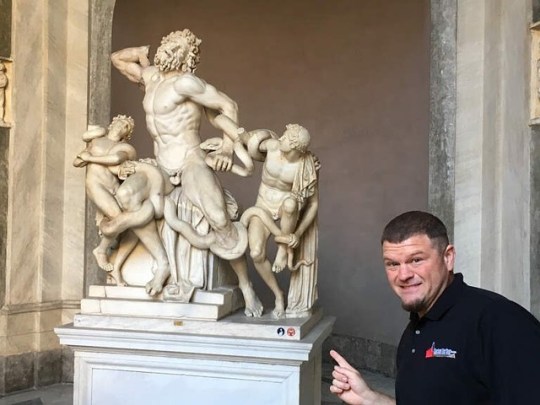#LaocoönAndHisSons
Text
Laocoön and His Sons

Agesander, Athenodoros, and Polydorus of Rhodes, Laocoön and His Sons. Marble, 208 cm × 163 cm × 112 cm. Vatican Museums, Vatican City.
Laocoön and His Sons is one of the most famous and complex sculptures from antiquity, housed today in the Vatican Museums. This masterpiece of Hellenistic art encapsulates the dramatic intensity and emotional depth characteristic of the period, making it a pivotal piece in the study of ancient sculptures. This blog post explores the sculpture's historical context, artistic significance, and the enduring impact it has on viewers and artists alike.
The Tale of Laocoön: Myth and Monument
The sculpture depicts the tragic fate of Laocoön, a priest of Troy, and his two sons, who were attacked by sea serpents sent by the gods. According to legend, Laocoön warned his fellow Trojans against accepting the Greek wooden horse, an act that led to his punishment by the gods who favored the Greeks. The group statue captures the moment of their agonizing death, with the serpents entwining their bodies in a deadly embrace.
Artistic Analysis: Expression and Technique
Laocoön and His Sons is renowned for its dynamic composition and the intense expression of agony. The figures are portrayed in a serpentine pose that suggests movement and struggle, enhancing the dramatic effect. The sculptors, believed to be Agesander, Athenodoros, and Polydorus of Rhodes, masterfully rendered the muscles and emotions of the figures, showcasing their technical prowess and deep understanding of human anatomy and emotion. The sculpture’s scale and the fine detailing of the muscles and sinews contribute to its lifelike appearance and emotional intensity.
Symbolism and Impact on Art History
This sculpture is not just a representation of physical pain but also symbolizes the human struggle against overpowering forces. Its discovery in 1506 near Rome had a profound impact on the Renaissance artists, who were inspired by its expressive power and realism. Michelangelo, in particular, was influenced by its muscular depiction and complex composition, elements that can be seen in his own work.
Contemporary Relevance and Interpretation
Over the centuries, Laocoön and His Sons has been interpreted in various ways, reflecting changing attitudes towards the role of fate and the gods in human life. It continues to inspire contemporary artists and scholars, who see in it themes of resistance, suffering, and the human condition. Its dramatic expression and execution make it a timeless piece that speaks to the fragility and heroism of mankind.
Conclusion: A Masterpiece of Human Expression
Laocoön and His Sons remains a pivotal work in the history of art, standing as a monument not only to Hellenistic artistry but also to the timeless themes of struggle and endurance. Its emotional depth and technical excellence continue to captivate and inspire, making it a central piece in the discourse on ancient and modern art.
Reflect and Respond
Considering the intense emotion and dynamic movement captured in Laocoön and His Sons, how do you see this sculpture in relation to modern representations of struggle and resistance in art? Can you think of any contemporary works that evoke a similar sense of drama and emotion?
#LaocoönAndHisSons#AncientSculpture#HellenisticArt#VaticanMuseums#ArtHistory#ClassicalSculpture#MythologyInArt#MichelangeloInfluence#ArtisticExpression#HumanStruggleInArt#artblogger
0 notes
Photo

The sculpture of #laocoön and his was found buried in #rome in 1506 and is considered “the prototypical icon of human agony”. It has been displayed at the #vatican since it was found. It is shown here in 2016 with our head guide Ryan. #laocoon #laocoönandhissons #vaticanmuseums #sculpture #bucketlist #bucketlisttourguide (at Vatican Museums - Musei Vaticani) https://www.instagram.com/p/B3zwpnRg1kE/?igshid=1myoorapjuus9
#laocoön#rome#vatican#laocoon#laocoönandhissons#vaticanmuseums#sculpture#bucketlist#bucketlisttourguide
1 note
·
View note